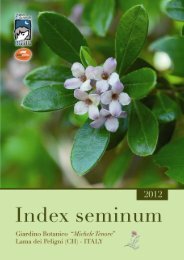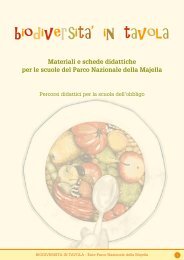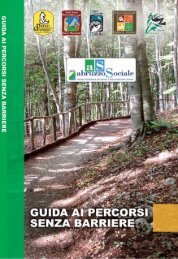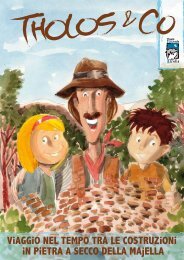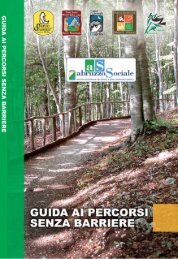Index Seminum 2010 Brescia - Parco Nazionale della Majella
Index Seminum 2010 Brescia - Parco Nazionale della Majella
Index Seminum 2010 Brescia - Parco Nazionale della Majella
Create successful ePaper yourself
Turn your PDF publications into a flip-book with our unique Google optimized e-Paper software.
Giardino Botanico “Daniela <strong>Brescia</strong>” di S. Eufemia a Maiella<br />
Il Giardino Botanico “D. <strong>Brescia</strong>”, localizzato a S. Eufemia a <strong>Majella</strong> (PE) nel <strong>Parco</strong> <strong>Nazionale</strong> <strong>della</strong> <strong>Majella</strong>, è<br />
stato creato nell’anno 2000 ed ospita circa 500 entità floristiche su una superficie di 43.000 mq. Nel 2003 è<br />
stato riconosciuto dalla Regione Abruzzo Giardino di Interesse Regionale ai sensi <strong>della</strong> L.R. n. 35/97.<br />
Il Giardino offre alcuni esempi di ambienti montani dell’Appennino Centrale, mentre una parte è dedicata a<br />
settori didattici dimostrativi, come ad esempio quello delle piante medicinali o il campo vetrina <strong>della</strong><br />
biodiversità agricola autoctona, dove sono coltivate varietà locali di melo e pero rinvenute nel territorio del<br />
<strong>Parco</strong>.<br />
Il Giardino è attraversato da due ruscelli con vegetazione ripariale naturale. Il laghetto presenta una ricca<br />
vegetazione, con numerose specie interessanti tipiche degli ambienti umidi e delle torbiere come ad esempio<br />
Iris pseudacorus, Caltha palustris, Ranunculus flammula, Menyanthes trifoliata, Eriophorum latifolium, varie<br />
Carex, ecc.<br />
Simbolo del Giardino è la Soldanella del calcare (Soldanella minima subsp. samnitica), scelta per il suo<br />
areale ristretto esclusivamente alla <strong>Majella</strong>. E’ una specie che si rinviene inpochissime stazioni a quote<br />
elevate caratterizzate da sgrottamenti soggetti a stillicidio.<br />
Di particolare interesse è la ricostruzione degli ambienti di rupi e ghiaioni di quota che ospitano specie<br />
tipiche <strong>della</strong> <strong>Majella</strong> tra cui endemismi come Cymbalaria pallida, Artemisia umbelliformis subsp. eriantha,<br />
Gentiana dinarica, Cerastium tomentosum, Achillea oxyloba subsp. barrellieri ecc.<br />
Presso il Giardino è presente un’ampia area destinata a vivaio dove vengono riprodotte specie arbustive e<br />
arboree autoctone con finalità reintroduttive. Inoltre presso il Giardino è possibile consultare l’erbario del<br />
<strong>Parco</strong> dove vengono conservati exiccata, raccolti prevalentemente sul massiccio <strong>della</strong> <strong>Majella</strong> e nelle aree<br />
limitrofe, per scopi scientifici e/o didattici.<br />
Daniela <strong>Brescia</strong>’s Botanical Garden of S. Eufemia a Maiella<br />
The “D. <strong>Brescia</strong>” Botanical Garden located in S. Eufemia a Maiella (PE) lay in the middle of the<br />
<strong>Majella</strong> National Park; it was established in the year 2000 and it saves about 500 plant species<br />
on an area of 43.000 square meters. The Garden has been planned offering some examples of<br />
Central Apennine habitats’ reconstruction; a wide area of the Garden is adduced to educational<br />
purposes. Two brooks, crossing the Garden, have a natural typical riparian vegetation.<br />
The symbol of the Garden is Soldanella minima subsp. samnitica, selected because of its narrow<br />
exclusive distribution area in the <strong>Majella</strong>. It is a subspecies that you can find only on few places,<br />
like high altitude cliffs characterized by endless strings of water.<br />
Particularly interesting is the reconstruction of cliffs and scree where several species typical of<br />
the <strong>Majella</strong> massif live, like the endemics Cymbalaria pallida, Gentiana dinarica, Cerastium<br />
tomentosum, Artemisia umbelliformis subsp. eriantha, Achillea oxyloba subsp. barrellieri and<br />
lots of other species.<br />
In the Garden there is a large area devoted to a nursery where shrubs and arbors species are<br />
reproduced with the aim of reintroduction. The <strong>Majella</strong> National Park herbarium preserve dried<br />
samples picked up on the <strong>Majella</strong> mountains and nearest areas; those samples can also be used<br />
as reference for scientific or educational purposes.<br />
3




